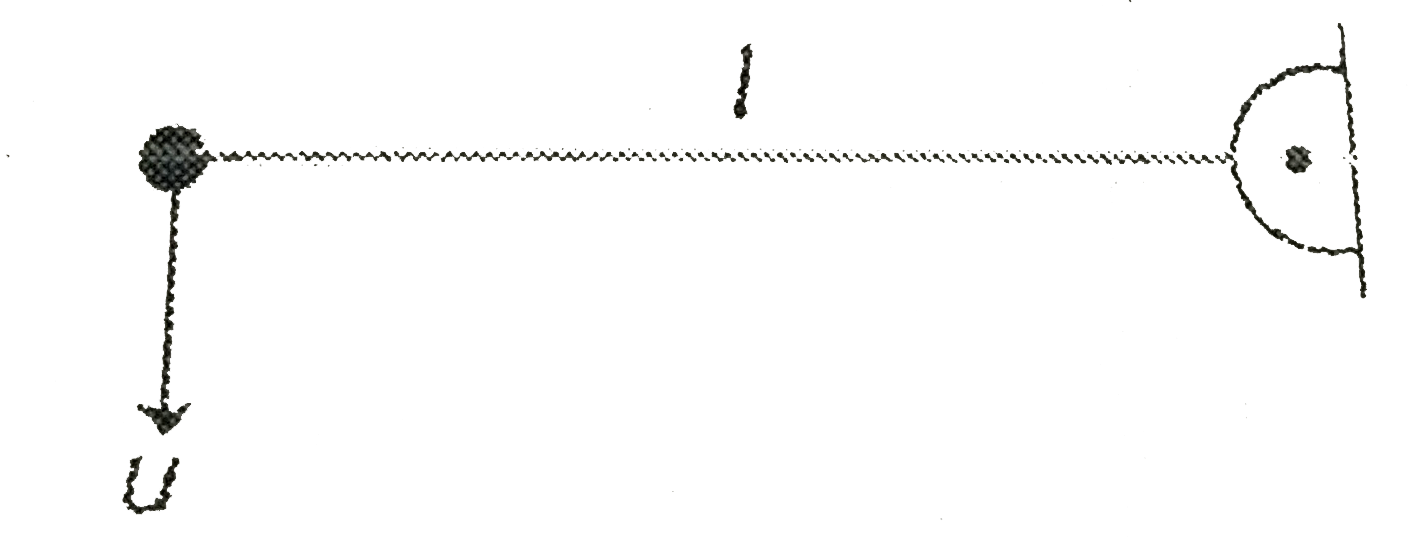A ball of mass 10−2kg and having charge +3×10−6C is tied at one end of a 1m along thread. The other end of the thread is fixed and a charge −3×10−6C is placed at this end. The ball can move in the circulr orbit of radius 1m in the vertical plane. Initially, the ball is at the bottom. Find the minimum initial horizontal velocity of the ball, so that it will be able to complete the full circle.
The correct Answer is:u=√58.1=7.6 m/s
To solve the problem, we need to find the minimum initial horizontal velocity of a ball with a mass of 10−2kg and charge +3×10−6C that is tied to a thread of length 1m and can move in a vertical circular motion around a charge of −3×10−6C located at the fixed end of the thread.
Step 1: Understand the Forces Acting on the Ball
At the top of the circular path, the ball experiences two forces:
1. Gravitational force (Fg=mg) acting downward.
2. Electrostatic force (Fe) due to the charge at the fixed end, also acting downward.
The centripetal force required to keep the ball in circular motion at the top is provided by the sum of these two forces.
Step 2: Write the Equation for Centripetal Force
At the top of the circle, the equation for centripetal force can be written as:
Fg+Fe=mv′2r
Where:
- v′ is the velocity of the ball at the top of the circle.
- r=1m is the radius of the circular path.
Step 3: Calculate the Electrostatic Force
The electrostatic force Fe between the two charges can be calculated using Coulomb's law:
Fe=k|q1q2|r2
Where:
- k=9×109N m2/C2
- q1=3×10−6C
- q2=−3×10−6C
- r=1m
Substituting the values:
Fe=9×109⋅(3×10−6)(3×10−6)12=9×109⋅9×10−12=81×10−3N=0.081N
Step 4: Set Up the Equation
Now substituting Fg and Fe into the centripetal force equation:
mg+Fe=mv′2r
Substituting m=10−2kg, g=10m/s2, and r=1m:
(10−2⋅10)+0.081=10−2v′21
0.1+0.081=10−2v′2
0.181=10−2v′2
v′2=0.181×102=18.1
v′=√18.1≈4.25m/s
Step 5: Apply Conservation of Energy
The total mechanical energy at the bottom must equal the total mechanical energy at the top:
12mv2=12mv′2+mg(2r)+Fe⋅2r
Where 2r=2m since the ball moves from the bottom to the top.
Substituting the values:
12(10−2)v2=12(10−2)(18.1)+(10−2)(10)(2)+0.081⋅2
12(10−2)v2=0.0905+0.2+0.162
12(10−2)v2=0.4525
v2=0.4525⋅210−2=90.5
v=√90.5≈9.52m/s
Final Answer
The minimum initial horizontal velocity of the ball required to complete the full circle is approximately 9.52m/s.
At the top of the circular path, the ball experiences two forces:
1. Gravitational force (Fg=mg) acting downward.
2. Electrostatic force (Fe) due to the charge at the fixed end, also acting downward.
At the top of the circle, the equation for centripetal force can be written as:
Fg+Fe=mv′2r
Where:
- v′ is the velocity of the ball at the top of the circle.
- r=1m is the radius of the circular path.
The electrostatic force Fe between the two charges can be calculated using Coulomb's law:
Fe=k|q1q2|r2
Where:
- k=9×109N m2/C2
- q1=3×10−6C
- q2=−3×10−6C
- r=1m
Fe=9×109⋅(3×10−6)(3×10−6)12=9×109⋅9×10−12=81×10−3N=0.081N
Now substituting Fg and Fe into the centripetal force equation:
mg+Fe=mv′2r
Substituting m=10−2kg, g=10m/s2, and r=1m:
(10−2⋅10)+0.081=10−2v′21
0.1+0.081=10−2v′2
0.181=10−2v′2
v′2=0.181×102=18.1
v′=√18.1≈4.25m/s
The total mechanical energy at the bottom must equal the total mechanical energy at the top:
12mv2=12mv′2+mg(2r)+Fe⋅2r
Where 2r=2m since the ball moves from the bottom to the top.
12(10−2)v2=12(10−2)(18.1)+(10−2)(10)(2)+0.081⋅2
12(10−2)v2=0.0905+0.2+0.162
12(10−2)v2=0.4525
v2=0.4525⋅210−2=90.5
v=√90.5≈9.52m/s
The minimum initial horizontal velocity of the ball required to complete the full circle is approximately 9.52m/s.
Topper's Solved these Questions
- ELECTROSTATICSBOOK - RESONANCE ENGLISHCHAPTER - ELECTROSTATICSEXERCISE - Part - II
23 Videos
- ELECTROMAGNETIC INDUCTIONBOOK - RESONANCE ENGLISHCHAPTER - ELECTROMAGNETIC INDUCTIONEXERCISE - A.l.P
19 Videos
- EXPERIMENTAL PHYSICSBOOK - RESONANCE ENGLISHCHAPTER - EXPERIMENTAL PHYSICSEXERCISE - PART -II
10 Videos
Similar Questions
A particle of mass 2×10−3 kg, charge 4×10−3C enters in an electric field of 5V/m, then its kinetic energy after 10 s is
View SolutionA ball of mass m is attached to one end of a light rod of length l, the other end of which is hinged. What minimum velocity v should be imparted to the ball downwards, so that it can complete the circle ?

View SolutionA ball is thrown vertically upwards. It returns 6 s later. Calculate the initial velocity of the ball. (Take g=10m s−2 )
View SolutionThe electric field strength in air at NTP is 3×106V/m. The maximum charge that can be given to a spherical conductor of radius 3m is
View SolutionA ball of mass 100g and having a charge of 4.9×10−5 C is released from rest in a region where a horizontal electric field of 2.0×104NC−1 exists. (a) find the resultant force acting on the ball. (b) What will be the path of the ball ? (c ) Where will the ball be at the end of 2 s?
View SolutionA proton of mass 1.67×10−27 kg and charge 1.6×10−19C is shot a uniform magnetic field, and perpendicular to the field with a velocity 5×106m/s. If the magnetic induction of the field is 1 tesla, find
(i) The radius of the circular path
View SolutionA small ball of mass 2×10−3kg, having a charge 1μC, is suspended by a string of length 0.8m. Another identical ball having the same charge is kept at the point of suspension. Determine the minimum horizontal velocity that should be imparted to the lower ball so that it can make a complete revolution.
View SolutionA charged partical having a charge of −2.0×10−6C is placed close to a nonconducting plate having a surface charge density 4.0 xx 10^(-6) C m^(-2). Fine the force of attraction between the particle and the plate.
View SolutionA ball of mass 1kg drops vertically on to the floor wit a speed of 25m/s. It rebounds with an initial velocity of 10m/s. What impulse acts on the ball during contact ?
View SolutionA pith ball of mass 9×10−5 kg carries a charge of 5μC. What must be charge in another pith ball placed directly 2 cm above the given pith ball such that they held in equilibrium?
View Solution
